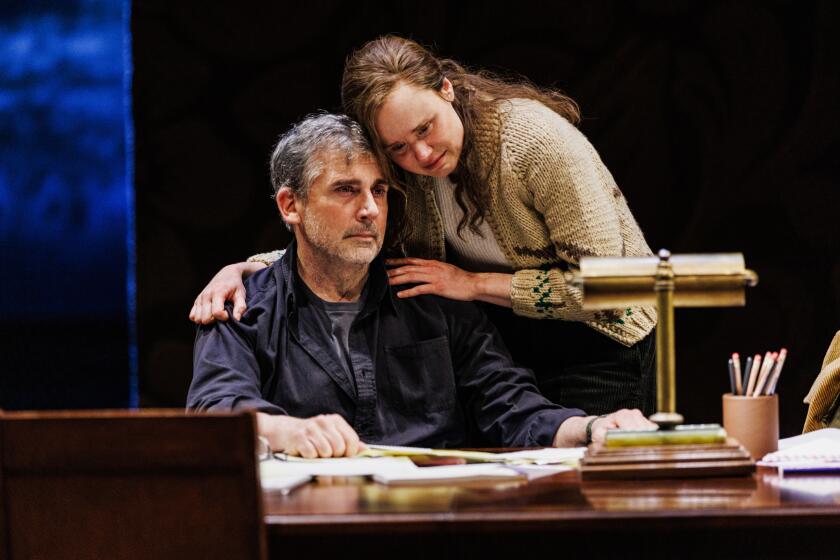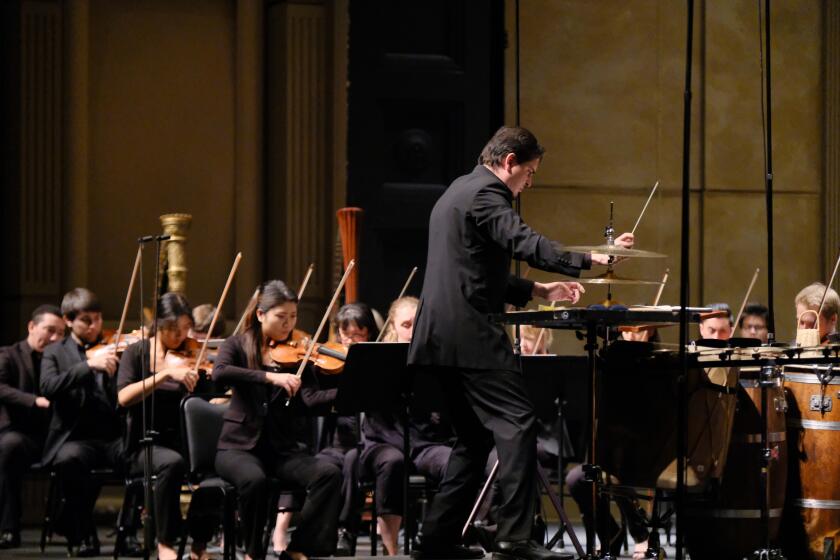ART REVIEW : Minimalism Focus of ‘Material Consequences’
In her catalogue essay for “Material Consequences,” an exhibition of sculpture at the Otis/Parsons Gallery through March 1, curator Anne Ayres describes the five artists included in the show as “sharing a noncynical engagement with late modernist possibilities.” In other words, these artists haven’t rejected the holy writ of minimalism--but then, who besides Jeff Koons has?
As is revealed by comparing the work in this show with Ace Gallery’s recent exhibition of ground-breaking minimalism (much of it from the ‘60s), there is little that’s new under the sun in the world of sculpture, and young artists continue to puzzle over the issues introduced by Judd, Nauman, Serra and the rest of that crowd: How mute can an artwork be and still communicate with the viewer? How can a sculpture fully engage the space it occupies? How much must a form move away from the wall in order to read as sculpture rather than a picture?
Systems, seriality, the use of industrial goods rather than “high” art materials such as marble and bronze--these themes have filled the pages of art magazines for three decades, and apparently they aren’t about to go away.
However, the fact that this rigorous school continues to thrive doesn’t mean that it’s become a widely accepted and understood style. In fact, only those with a sophisticated knowledge of minimalism will get the subtle nuances in “Material Consequences”--even though its central nuance is a fairly simple one. This is a softened, cuddly version of minimalism--minimalism cross-bred with the organic emotionality of Joseph Beuys.
Forms tend toward the slightly eccentric, and two of the artists, Peter Levinson and Nicola Atkinson-Griffith, employ decorative motifs. Less austere than pure minimalism, this art employs common materials (rubber, rope, scrap wood, cardboard), leaves processes exposed (we see the saw marks on the wood, the unfinished edges and hardware), and comports itself with a casual, crafted-in-the-garage quality.
The gallery entrance way is given over to Atkinson-Griffith, a British artist whose “Monumental Activity” is a three-part piece involving an exterior wall on Wilshire Boulevard (where she’s erected a fan-shaped construction made of tin, rope and hardware), an exterior display case, and an interior display case that she has sealed up with wood painted with decorative patterning evocative of wallpaper. The three sections fail to come together in any comprehensible way.
Jeff Colson laminates concentric circles of plywood into eliptical forms that have the kooky quality of darning eggs, while Pat Nickell’s geometric wooden forms are clearly indebted to Donald Judd. Work by Jacci Den Hartog simultaneously alludes to the felt pieces of Robert Morris, Pop and surrealism. Her “Untitled (Elephants II),” made from thin sheets of black rubber, is like a chain of paper dollies suspended from the ceiling; the shape that’s repeated is evocative of the ears and trunk of an elephant, hence the title. A small work that lies on the floor like a throw rug is made of black rubber cut in the shape of a Pop art flower-power symbol, while her “Untitled (Stack)” is a vertical column of what appear to be 14 black rubber inner tubes wearing tutus. There’s a goofy sensuality to Den Hartogs’ work that puts one in mind of Claes Oldenburg.
The most compelling piece in the show is Peter Levinson’s massive installation, “Prospect.” Levinson’s taken a small chamber and sealed it off with a fence made of horizontal slats in the manner of a corral. This forbidding fence is 11 feet high and painted black, so there is no thought of scaling it. Peer through the slats and one sees a smaller structure, also made of black wood, that in turn houses a a bizarre object--a pole supporting an ornate form--that looks as though it belongs in a medieval pageant. Finished off here and there with Baroque embellishments made of black cardboard, the piece is impenetrable on every level.
Levinson’s work is impossible to enter and inspect it fully, nor is it possible to slot it into any known category of art. Consequently, it resonates in the memory like a mysterious structure glimpsed from the window of a train.
More to Read
The biggest entertainment stories
Get our big stories about Hollywood, film, television, music, arts, culture and more right in your inbox as soon as they publish.
You may occasionally receive promotional content from the Los Angeles Times.






